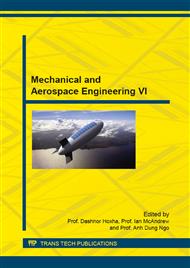[1]
Yu.A. Mashkov, Tribology of constructional materials, Omsk: OSTU, 2001, p.299.
Google Scholar
[2]
E.N. Kablov, The strategic direction of development of materials and technologies of their processing for the period till 2030, Aviation materials and technologies, M.: VIAM. pp.7-17, (2012).
Google Scholar
[3]
Yu.N. Drozdov, Yu. N. Naumov, M. A. Tananov, A tribology in space, Friction and greasing in machines and mechanisms, 2009, N. 2, pp.41-46.
Google Scholar
[4]
I.E. Vyakhkhi, P. D. Gonchar, M. A. Ivanki, G. N. Lavrukhi, A.A. Movchan, A.N. Semeno, A.F. Chevagin, Technical solutions for adaptive aviation designs with use of alloys with shape memory, Scientific notes of TsAGI, Volume XXXVIII, 2007, N. 3 - 4, pp.158-168.
Google Scholar
[5]
Zh.M. Blednova, N. A. Makhutovm.I. Chayevsky, Superficial modifying by materials with effect of memory of forms", Krasnodar, "Publishing house South, 2009, p.354.
Google Scholar
[6]
Wangyang Ni, Yang-Tse Cheng, David S. Grummon, Wear resistant self-healing tribological surfaces by using hard coatings on NiTi shape memory alloys, Surface and Coatings Technology. Volume 201, pp.1053-1057.
DOI: 10.1016/j.surfcoat.2006.01.067
Google Scholar
[7]
Wangyang Ni, Yang-Tse Cheng, Michael Lukitsch, Anita M. Weiner, Lenoid C. Lev, David S. Grummon, Novel layered tribological coatings using a superelastic NiTi interlayer, Wear, 2005, V. 259, pp.842-848.
DOI: 10.1016/j.wear.2005.01.015
Google Scholar
[8]
Blednova Zh.M., Stepanenko M. A. Regularities of formation of blankets from material with effect of shape memory from a position of technological inheritance, the Strengthening technologies and coverings. 2015. No. 6.
Google Scholar
[9]
Zh.M. Blednova, P.O. Rusinov. Mechanical and Tribological Properties of the Composition Steel - nanostructured Surface Layer of a Material with Shape Memory Effect Based TiNiCu, Applied Mechanics and Materials, 2014, V. 592-594. pp.1325-1330.
DOI: 10.4028/www.scientific.net/amm.592-594.1325
Google Scholar
[10]
Zh.M. Blednova, P.O. Rusinov, M.A. Stepanenko. Influence of Superficial Modification of Steels by Materials with Memory Effect of the Form on Wear-fatigue Characteristics at Frictional-cyclic Loading, Advanced Materials Research, Vols. 915-916 (2014).
DOI: 10.4028/www.scientific.net/amr.915-916.509
Google Scholar
[11]
Zh.M. Blednova, N. A. Makhutov, P. O. Rusinov, M. A. Stepanenko. Mechanical and tribological properties of multipurpose composition a basis - material with shape memory, created in the conditions of high-energy influences, Factory laboratory. Diagnostics of materials, 2015, N. 2. pp.41-49.
DOI: 10.1134/s0020168516150036
Google Scholar
[12]
A.D. Pogrebnyak, S. N. Bratushka, M. V. Ilyashenko, N. A. Makhmudov, O. V. Kolisnichenko, Yu. N. Tyurin, V. V. Uglov, A. V. Pshik, M. V. Kaverin. Tribotechnical and physicomechanical properties of sheetings from Ni-Cr-B-Si-Fe/WC-Co-Cr before and after an melting plasma stream, Friction and wear, 2011. V. 32, N. 2, pp.122-130.
DOI: 10.3103/s1068366611020085
Google Scholar
[13]
S.N. Kulkov, V.V. Ruda. The microstructure of the composite material TiC-TiNi micro gradient structurally unstable matrix, Proceedings of the higher educational institutions, Physics. 2012. V. 55. N. 5-2. pp.166-169.
Google Scholar
[14]
Yu.I. Gordeev, A.K. Abkarian, G.M. Zeer, A.A. Lepeshev, Influence of adding alloy ceramic nanoparticles on structural parameters and features of hard alloys, Vestnik SibSAU. № 3(49). 2013. pp.174-181.
Google Scholar


